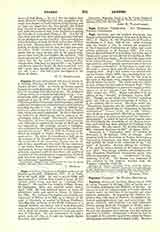

Pagnino, SANTES (or XANTES), Dominican, b. 1470 at Lucca, Tuscany; d. August 24, 1541, at Lyons, one of the leading philologists and Biblicists of his day. At sixteen he took the religious habit at Fiesole, where he studied under the direction of Savonarola and other eminent professors. In acquiring the Oriental languages, then cultivated at Florence, he displayed unwonted quicksightedness, ease, and penetration. His genius, industry, and erudition won him influential friends, among them the Cardinals de’Medici, subsequently Leo X and Clement VII. As a sacred orator his zeal and eloquence kept abreast with his erudition and were as fruitful. Summoned to Rome by Leo X, he taught at the recently opened free school for Oriental languages until his patron’s death (1521). He then spent three years at Avignon and the last seven years of his life at Lyons. Here he was instrumental in establishing a hospital for the plague-stricken, and, by his zeal and eloquence, diverted an irruption of Waldensianism and Lutheranism from the city, receiving in acknowledgement the much coveted rights and privileges of citizenship. The epitaph, originally adorning his tomb in the Dominican church at Lyons, fixes the date of his death beyond dispute. The merit of his “Veteris et Novi Testamenti nova translatio” (Lyons, 1527) lies in its literal adherence to the Hebrew, which won for it the preference of contemporary rabbis and induced Leo X to assume the expenses of publication. After the pontiff’s death these devolved on the author’s relatives and friends. Several editions of it, as well as of the monumental “Thesaurus linguae sanctae” (Lyons, 1529), were brought out by Protestants as well as Catholics. Among other productions, all of which treat of Sacred Scripture, Greek, or Hebrew, were “Isagoges seu introductions ad sacras literas liber unus” (Lyons, 1528, etc.), and “Catena argentea in Pentateuchum” in six volumes (Lyons, 1536).
THOS. K. REILLY

